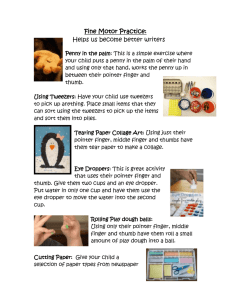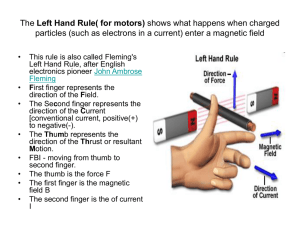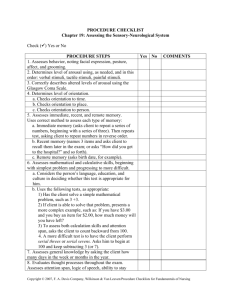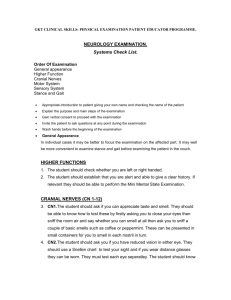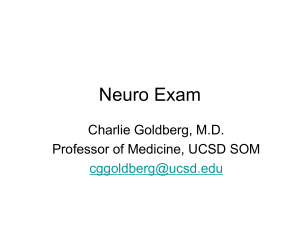Neurological Assessment Evaluation Form - Nursing
advertisement
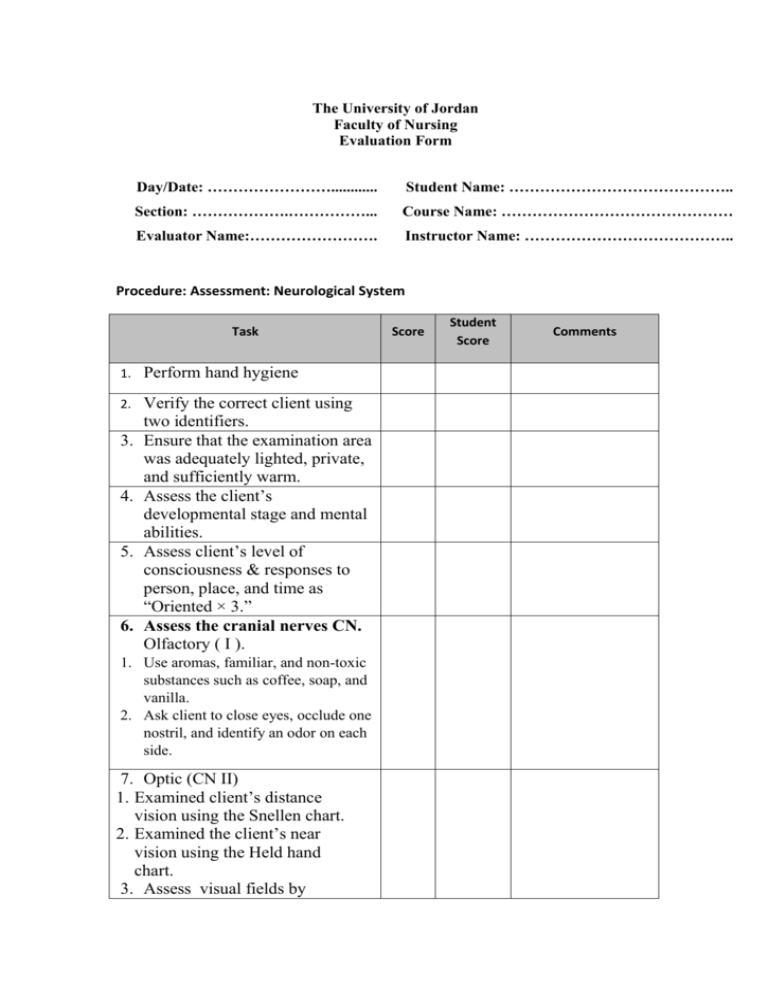
The University of Jordan Faculty of Nursing Evaluation Form Day/Date: ……………………............ Student Name: …………………………………….. Section: ……………….……………... Course Name: ……………………………………… Evaluator Name:……………………. Instructor Name: ………………………………….. Procedure: Assessment: Neurological System Task 1. Perform hand hygiene 2. Verify the correct client using two identifiers. Ensure that the examination area was adequately lighted, private, and sufficiently warm. Assess the client’s developmental stage and mental abilities. Assess client’s level of consciousness & responses to person, place, and time as “Oriented × 3.” Assess the cranial nerves CN. Olfactory ( I ). 3. 4. 5. 6. 1. Use aromas, familiar, and non-toxic substances such as coffee, soap, and vanilla. 2. Ask client to close eyes, occlude one nostril, and identify an odor on each side. 7. Optic (CN II) 1. Examined client’s distance vision using the Snellen chart. 2. Examined the client’s near vision using the Held hand chart. 3. Assess visual fields by Score Student Score Comments confrontation 8. Oculomotor (CN III), trochlear (CN IV), abducens (CN VI): Measured Extra Ocular Muscles (EOM). 1. Asked the client to follow Assess pupils Size, regularity, equality, pupillary reaction, and accommodation. 2. Assess six ocular directions by six cardinal gaze, cover test, and corneal light reflex 9. Trigeminal (CN V): 1. Palpate the temporal & masseter muscles, While the client to clenching the teeth. Note the strength of muscle contraction. 2. Using a fine wisp of cotton. Ask the client to respond whenever you touch the skin. 10. Facial (CN VII): 1. Observed face for symmetry. Had the client frown, smile, show teeth, puff cheeks, raise eyebrows and close eyes tightly. Then close against resistance. 2. Assess the client's taste 11. Acoustic CN Vlll): Assess the hearing with the whispered voice test, Rinne test, and Weber test. 12. Glossopharyngeal (CN IX), vagus (CN X), 1. Assessed speech, observed swallowing. 2. Asked the client to say “ahh” while holding the tongue down with a tongue blade and observing the uvula with a penlight. 3. Checked for midline uvula and rise of uvula and soft palate. 4. Using the tongue blade, pressed on posterior tongue to elicit a gag reflex. 5. Assess the bitter taste. 13. Accessory (CN XI) 1. Had the client sit upright and shrug shoulders while applying resistance with hands on shoulders. 2. Had the client turn head left & right while applying resistance with hands on the side of the head. 14. Hypoglossal (CN XII): 1. Instructed the patient to open his or her mouth and move the tongue side to side. Note the forward thrust in the midline. 2. Ask the client to say "Light tight Dynamite". Note lingual speech.(sound of letters I, t, d, & n) is clear & distinct. 15. Assessed motor and cerebellar function. Gait: Ask the client to walk 1020 ft. turns and return to the starting point. 16. Tandem walk: Ask the client to walk a straight line, placing the heel of one foot directly in front of the toes of the other foot. 17. Shallow bend knee: Ask the client to close eyes and stand on one foot, then the other. 18. Heel-to-Shin- test Ask the client to place one heel on the opposite knee, and then run it down the shin to the big toe. Note the smoothness and accuracy of the movements. Repeat on the other side. 19. Romberg test: Ask the client to stand with feet together and arms resting at the sides, first with eyes open, and then closed. Note any swaying. 20. Alternating Supination and Pronation of Hands on Knees: Ask the client to pat both knees with the palms of both hands and then with the backs of hands, alternately, at an everincreasing rate. 21. Finger-to-finer Test: Ask the client to abduct and extend arms at shoulder height and rapidly touch nose alternately with one index finger and then the other. Have the client repeat the test with eyes closed if the test is performed easily. 22. Finger to Nose and to the Nurse’s Finger: Ask the client to touch nose and then your index finger, held at a distance at about 45 cm (18 inches), at a rapid and increasing rate. 23. Opposition( Fingers to Thumb ): Ask the client to touch each finger of one hand to the thumb of the same hand as rapidly as possible 24. Assessed extremities for sensation. Pain sensation. Ask the client to close his eyes and to say “sharp,” “dull,” or “don’t know” when the sharp or dull end of the broken tongue depressor is felt. Alternately, use the sharp and dull end of the sterile pin or needle to lightly prick designated anatomic areas at random. Allow at least two seconds between each test. 25. Light-touch sensation: 1. Ask the client to close eyes and to respond by saying “yes” or “now” whenever the client feels the cotton wisp touching skin. 2. With a wisp of cotton, lightly touch one specific spot and then the same spot on the other side of the body. 3. Test areas on the forehead, cheek, hand, lower arm, abdomen, foot, and lower leg. Check a distal area of the limb first. 26. Temperature Sensation: 1. Touch skin areas with test tubes filled with hot or cold water. 2. Have the client respond say saying “hot,” “cold,” or “don’t know.” 27. Vibration sensation: 1. Applied the stem of a vibrating tuning fork to distal joints of toes and fingers. 2. Client to indicate when the vibration starts and stopped. 28. Position(Kinesthetic) 1. Grasp the client’s a middle finger or a big toe firmly between your thumb and index finger, and exert the same pressure on both sides of the finger or toe while moving it. 2. Use a series of brisk up-and-down movements before bringing the finger or toe suddenly to rest in one of the three positions. 29. Stereognosis: Place familiar objects—such as a key, paper clip, or coin—in the client’s hand, and ask the client to identify them. 30. Graphesthesia: write a number or letter on the client’s palm, using a blunt instrument, and ask the client to identify it. 31. Assess the deep tendon reflexes: Test reflexes using a percussion hammer, comparing one side of the body with the other to evaluate the symmetry of response. 32. Biceps Reflex( C5 – C6): 1.Partially flex the client’s arm at the elbow, and rest the forearm over the thighs, placing the palm of the hand down. 2.Place the thumb of your nondominant hand horizontally over the biceps tendon and strike a blow on the thumb.Note slight flexion of the elbow. 33. Triceps Reflex ( C7 - C8). 1.Flex the client’s arm at the elbow, and support it by holding the upper arm. 2.Palpate the triceps tendon just above the elbow and strike with the percussion hammer directly to the tendon. Note slight extension of the elbow. 34. Brachioradialis Reflex(C5 C6). 1. Rest the client’s arm in a relaxed position on your forearm or on the client’s own leg. 2. Deliver a blow with the percussion hammer directly on the radius 2–5 cm (1–2 inches) above the wrist or the styloid process, the bony prominence on the thumb side of the wrist. Note flexion and supination of the forearm with the fingers extend slightly. 35. Patellar Reflex ( L2. L3). 1. Ask the client to sit on the edge of the examining table so that legs hang freely. 2. Locate the patellar tendon directly below the patella. 3. Deliver a blow with the percussion hammer directly to the tendon. Note extension leg 36. Achilles Reflex (S1 – S2) 1. With the client in the same position as for the patellar reflex test, Hold the foot in dorsiflexion 2. . Deliver a blow with the percussion hammer directly to the Achilles tendon just above the heel. Note plantar flexion (downward jerk) of the foot. 37. Plantar (Babinski’s) Position the thigh in slight external rotation. Use the handle of the percussion hammer, draw Stroke the lateral border of the sole of the alight stroke up lateral side of the sole of the foot inward across the ball of the foot toward the big toe, like upside- down J. Note toes bend downward. 38. Performed hand hygiene. 39. Document or report findings of the client.
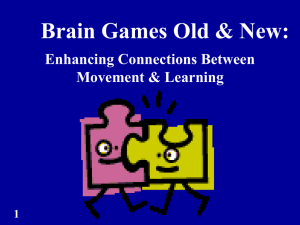
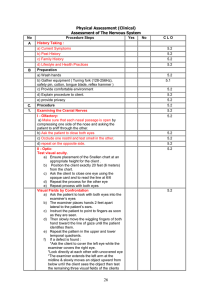
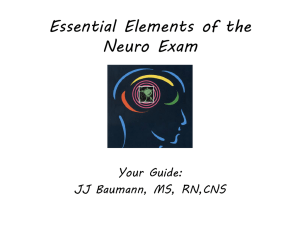
![Measuring Reaction Times (modified) [word document]](http://s3.studylib.net/store/data/005890593_1-f3403f0a4fee937a93ebd23d2df416ab-300x300.png)

